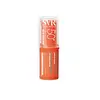What's inside
What's inside
 Key Ingredients
Key Ingredients

 Benefits
Benefits

 Concerns
Concerns

No concerns
 Ingredients Side-by-side
Ingredients Side-by-side

Coco-Caprylate/Caprate
EmollientEuphorbia Cerifera Wax
Diethylamino Hydroxybenzoyl Hexyl Benzoate
UV FilterC15-19 Alkane
SolventBis-Ethylhexyloxyphenol Methoxyphenyl Triazine
Skin ConditioningCopernicia Cerifera Wax
Caprylic/Capric Triglyceride
MaskingEthylhexyl Triazone
UV AbsorberTheobroma Cacao Seed Butter
EmollientCalcium Starch Octenylsuccinate
AbsorbentParfum
MaskingPrunus Armeniaca Kernel Oil
MaskingHelianthus Annuus Seed Oil
EmollientTocopherol
AntioxidantVanillin
MaskingCoco-Caprylate/Caprate, Euphorbia Cerifera Wax, Diethylamino Hydroxybenzoyl Hexyl Benzoate, C15-19 Alkane, Bis-Ethylhexyloxyphenol Methoxyphenyl Triazine, Copernicia Cerifera Wax, Caprylic/Capric Triglyceride, Ethylhexyl Triazone, Theobroma Cacao Seed Butter, Calcium Starch Octenylsuccinate, Parfum, Prunus Armeniaca Kernel Oil, Helianthus Annuus Seed Oil, Tocopherol, Vanillin
Propylheptyl Caprylate
EmollientOctyldodecanol
EmollientDicaprylyl Carbonate
EmollientDiethylamino Hydroxybenzoyl Hexyl Benzoate
UV FilterTriethyl Citrate
MaskingTributyl Citrate
SolventEthylhexyl Triazone
UV AbsorberBis-Ethylhexyloxyphenol Methoxyphenyl Triazine
Skin ConditioningDibutyl Lauroyl Glutamide
Skin ConditioningDiethylhexyl Butamido Triazone
UV AbsorberDibutyl Ethylhexanoyl Glutamide
Skin ConditioningLepidium Sativum Sprout Extract
Skin ConditioningHelianthus Annuus Seed Oil
EmollientTocopherol
AntioxidantCaprylic/Capric Triglyceride
MaskingPropylheptyl Caprylate, Octyldodecanol, Dicaprylyl Carbonate, Diethylamino Hydroxybenzoyl Hexyl Benzoate, Triethyl Citrate, Tributyl Citrate, Ethylhexyl Triazone, Bis-Ethylhexyloxyphenol Methoxyphenyl Triazine, Dibutyl Lauroyl Glutamide, Diethylhexyl Butamido Triazone, Dibutyl Ethylhexanoyl Glutamide, Lepidium Sativum Sprout Extract, Helianthus Annuus Seed Oil, Tocopherol, Caprylic/Capric Triglyceride
 Reviews
Reviews

Ingredients Explained
These ingredients are found in both products.
Ingredients higher up in an ingredient list are typically present in a larger amount.
You might know this ingredient as Tinosorb S or Bemotrizinol. It is a UV filter that covers both UVA and UVB rays.
This ingredient has two peak UV absorption peaks ( 310 and 340 nm) and is able to absorb both UV-A and UV-B rays. This ingredient works by preventing UV rays from reaching and damaging your skin.
On top of that - it is highly photostable and helps prevent the photodegration of other sunscreen ingredients such as avobenzone.
Tinosorb S is allowed in the EU, Australia, and Asia. It is close to being approved by the FDA and we'll hopefully get this ingredient in the U.S. by late 2025.
Fun fact: Tinosorb S is the most effective UV absorber at maximum concentration (measured by SPF) permitted in the EU.
This ingredient is oil-soluble, so your oil-cleansers will take this right off at night.
Learn more about Bis-Ethylhexyloxyphenol Methoxyphenyl TriazineThis ingredient is an emollient, solvent, and texture enhancer. It is considered a skin-softener by helping the skin prevent moisture loss.
It helps thicken a product's formula and makes it easier to spread by dissolving clumping compounds.
Caprylic Triglyceride is made by combining glycerin with coconut oil, forming a clear liquid.
While there is an assumption Caprylic Triglyceride can clog pores due to it being derived from coconut oil, there is no research supporting this.
Learn more about Caprylic/Capric TriglycerideDiethylamino Hydroxybenzoyl Hexyl Benzoate (DHHB) is a chemical UV-A absorber. It is formulated for high UVA protection (320-400 nm).
DHHB is well-liked for:
DHHB has been approved by the EU, Japan, Taiwan, and South America for use up to 10%. Unfortunately, it has not been approved for use in the US or Canada due to slow regulatory processes.
This ingredient is soluble in oils, fats, and lipids.
Learn more about Diethylamino Hydroxybenzoyl Hexyl BenzoateEthylhexyl Triazone is a modern chemical sunscreen that protects from UV-B radiation.
It is the most effective of existing UV-B filters, as it provides the highest level of photo-stable absorption. It protects from the entire UV-B range (280 to 320nm), with it's highest level of protection at 314nm.
Ethylhexyl Triazone is oil soluble, oderless and colorless, which mean it is able to be incorporated into a variety of different formulations.
It is not currently available within the United States due to slow changing FDA regulations. Outside of the US, it is used in formulations at concentrations up to 5%.
Learn more about Ethylhexyl TriazoneHelianthus Annuus Seed Oil is the oil derived from the seeds of a Sunflower. Sunflower seed oil is non-fragrant. It is an emollient, meaning it helps to soften the skin.
Sunflower seed oil contains many fatty acids. The fatty acids found in sunflower seeds include (from highest amount to least): linoleic acid, myristic acid, palmitic acid, stearic acid, arachidic acid, oleic acid, and linolenic acid.
These fatty acids help the skin create ceramides. Ceramides play a role in repairing the skin barrier.
Helianthus Annuus Seed Oil helps moisturize the skin. This in turn helps the skin look more rejuvenated and smoother.
Sunflowers are rich in vitamin E.
Historians believe Indigenous cultures of North America domesticated sunflowers before corn. Thus they relied on sunflower oil for a variety of uses. One such use is moisturizing skin and hair.
Sunflower seed oil may not be fungal acne safe. We recommend speaking with a professional if you have any concerns.
Learn more about Helianthus Annuus Seed OilTocopherol (also known as Vitamin E) is a common antioxidant used to help protect the skin from free-radicals and strengthen the skin barrier. It's also fat soluble - this means our skin is great at absorbing it.
Vitamin E also helps keep your natural skin lipids healthy. Your lipid skin barrier naturally consists of lipids, ceramides, and fatty acids. Vitamin E offers extra protection for your skin’s lipid barrier, keeping your skin healthy and nourished.
Another benefit is a bit of UV protection. Vitamin E helps reduce the damage caused by UVB rays. (It should not replace your sunscreen). Combining it with Vitamin C can decrease sunburned cells and hyperpigmentation after UV exposure.
You might have noticed Vitamin E + C often paired together. This is because it is great at stabilizing Vitamin C. Using the two together helps increase the effectiveness of both ingredients.
There are often claims that Vitamin E can reduce/prevent scarring, but these claims haven't been confirmed by scientific research.
Learn more about Tocopherol